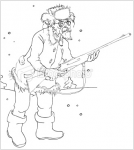Welcome guest, is this your first visit? Create Account now to join.
Welcome to the NZ Hunting and Shooting Forums.
Search Forums
User Tag List
+ Reply to Thread
Results 16 to 30 of 32
-
18-12-2013, 12:59 PM #16
-
-
18-12-2013, 01:45 PM #17
its pretty simple zharn....
What you said earlier "Change of direction whistle"... There is that which you can use. All I am saying is that you don't always need that.
If your dog is paying attention to you and keeps track of your movement (and they should) then they will follow you.
If they are far out where you don't want him to be just go the opposite direction and he should follow. At least Aki does for me.... Avoids whistling and yelling...
Its natural for a dog to always stay in front of you, turn your back against him he'll come in front again.
-
18-12-2013, 02:26 PM #18
you are still describing how to train a dog to quarter
-
18-12-2013, 02:58 PM #19
so whats the change of direction whistle for?
woukd be good to elaborate on ur method...
-
18-12-2013, 03:17 PM #20
-
18-12-2013, 04:43 PM #21
we'll ask you for a demo when we get up north

I need to be refreshed on the fish retrieve too
-
18-12-2013, 09:26 PM #22
as mentioned terrain dependent is what a desirable cast length will be for most . i my myself dont give a toss as long as i can see him the bigger the more exciting and less ground i need to cover--as long as the dog isnt self hunting ! ie he turns and cast back to you i think its just personal preference and how much you trust your mutt .the working partnership is a highway not a caldersack --you gotta keep workin on it if changing terrain- unless of course your dog is perfect
Tweed or not to Tweed that is the question
-
18-12-2013, 09:41 PM #23
Munsey to answer your question, As UU said if he's too far turn him. If he is too close and therefore missing ground or habitually short casting on one side, stop him, and send him back out.
Eeebees, I want a dog that fills any space you give it. As mentioned above, if the ground treatment is relevant to terrain there is no such thing as too big
-
18-12-2013, 09:57 PM #24
Good to see you are still alive & well el b, been quiet with out you
-
18-12-2013, 09:59 PM #25
-
18-12-2013, 10:30 PM #26
im always gonna comment on the fish retrieve...
-
19-12-2013, 08:38 PM #27
-
19-12-2013, 09:00 PM #28OPCz


- Join Date
- Jun 2012
- Location
- Nor West of Auckland on the true right of the Kaipara River
- Posts
- 34,747
It takes 43 muscle's to frown and 17 to smile, but only 3 for proper trigger pull.
What more do we need? If we are above ground and breathing the rest is up to us!
Rule 1: Treat every firearm as loaded
Rule 2: Always point firearms in a safe direction
Rule 3: Load a firearm only when ready to fire
Rule 4: Identify your target beyond all doubt
Rule 5: Check your firing zone
Rule 6: Store firearms and ammunition safely
Rule 7: Avoid alcohol and drugs when handling firearms
-
19-12-2013, 09:13 PM #29
I agree, Pointer. Re the dog missing ground...its an interesting one...a dog can work in a busy fashion but is he really doing the work he needs to...does prey drive come into this, I suggest it does. If a puppy is missing ground that is one thing, but an experienced dog is another...how much ground is missing ground (I guess again it is the terrain) but how much ground is too much ground? If that ground is not holding birds, or there are no birds, can and/or should the dog be remonstrated (or at least corrected) for missing ground?
...amitie, respect mutuel et amour...
...le beau et le bon, cela rime avec Breton!...
-
20-12-2013, 06:02 PM #30
Similar Threads
-
Cast bullet help
By PerazziSC3 in forum Reloading and BallisticsReplies: 30Last Post: 05-01-2014, 04:25 PM -
lead for hard cast bullets.
By misfire in forum Reloading and BallisticsReplies: 13Last Post: 12-12-2013, 10:30 PM -
Cast Bullets
By gimp in forum Reloading and BallisticsReplies: 9Last Post: 28-05-2013, 12:56 PM -
What sort of 223?
By gadgetman in forum Firearms, Optics and AccessoriesReplies: 30Last Post: 13-09-2012, 09:49 PM
Tags for this Thread
Welcome to NZ Hunting and Shooting Forums! We see you're new here, or arn't logged in. Create an account, and Login for full access including our FREE BUY and SELL section Register NOW!!





 13Likes
13Likes LinkBack URL
LinkBack URL About LinkBacks
About LinkBacks




 Reply With Quote
Reply With Quote


Bookmarks